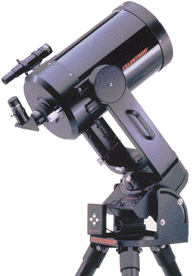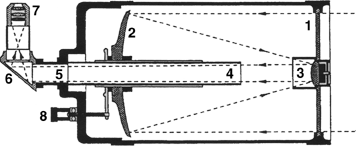Celestron History
![]() Distribution
Distribution ![]() News
News ![]() Notes & Interesting Articles
Notes & Interesting Articles ![]() Products
Products ![]() Pricing
Pricing ![]() Quality Assurance
Quality Assurance

Celestron Celestar 8 Schmidt-Cassegrain Telescope
 The Celestar 8 telescope is a very light weight and economical 8" Schmidt-Cassegrain
telescope with a nominal focal length of 2032mm (f/10). Made in the U.S.A.! It features
the exact same quality of view as its more sophisticated Celestron cousins, with a
simpler mount and accessories package. This design is sophisticated yet simple and fun to use. No complex bells or whistles slow you down or interfere with operation. Set up is quick leaving you time to enjoy yourself and your observing.
The Celestar 8 telescope is a very light weight and economical 8" Schmidt-Cassegrain
telescope with a nominal focal length of 2032mm (f/10). Made in the U.S.A.! It features
the exact same quality of view as its more sophisticated Celestron cousins, with a
simpler mount and accessories package. This design is sophisticated yet simple and fun to use. No complex bells or whistles slow you down or interfere with operation. Set up is quick leaving you time to enjoy yourself and your observing.
Company Seven generally recommends that adults interested in astronomy acquire nothing less than an 8 inch aperture in a mirror telescope design. The Celestron 8 provides a good value for astronomy. With more than 635 times the effective light gathering power of the human eye (to observe the faint deep sky objects), and with the clear magnification capability (up to about 450-480x usable depending on accessories quality and local seeing conditions) that is particularly desirable for views of the changing major features of the larger planets (Venus, Mars, Jupiter, Saturn in particular).
The complete telescope optical tube assembly with attached fork mount and drive weigh just 28 lbs. Add the furnished Wedgepod (an integrated wedge and fixed height field tripod) and the total weight is only 37 lbs. We regularly demonstrate how an average adult can lift the complete telescope and wedgepod from the floor of our showroom with one hand! This is ideal for the youngster, or elderly astronomer or astrophotographer on the go who can not manage the more substantial telescopes.
The Wedgepod tilt plate facilitates Polar Alignment at any latitude from 0 to 90 degrees! In fact, the system can therefore be used as an alt-azimuth mount. These factors render the Celestar 8 a good choice for those who wish to employ the telescope for applications such as an ultra telephoto or video lens, or as a terrestrial telescope for long distance observing of birds, or even a space craft launch!
The Celestar 8 telescope employs a "clock drive" tracking system (the early telescope drives were based on modified clocks - these drives rotate a telescope once every 24 hours or so). When properly set up, this mechanism will compensate for the apparent motion of celestial objects across the sky as the Earth rotates. Such a drive system allows you to find and object and precisely center it (there are manual fine motion controls on the fork mount, or optional electronics to fine adjust both axes) in an eyepiece, where it will remain there permitting you and your friends or family to enjoy the views completly free of any distractions. Furthermore, the setting circles provided on the fork mount allow one to find their way across the sky to find the faint otherwise difficult to find objects using the two dimensional coordinate system employed by professional and amateur astronomers. We highly encourage tracking mounts as this for use by those with young children, or especially if sharing a telescope for astronomy with others. Such a tracking drive is a necessity for astrophotography of most celestial objects.
The electromechanical drive system is the same as used on the Celestron C-5+ Schmidt-Cassegrain telescope and described in detail on our Web page. The DC drive system electronics and replaceable battery are built-in to the drive base. It will operate from a single, easy to find 9-volt alkaline battery for about 50 hours anywhere in the world. So the operation is totally cordless and independent of local power. The Right Ascension drive motor is reversible and so it can operate in either Northern or Southern hemispheres. A built in drive corrector can be activated with an optional hand control to make fine tracking adjustments. The hand control allows fast and slow manual override of the R.A. tracking speed and operation of the optional Declination motor thereby facilitating time exposure astrophotography, and compensating for any errors of Polar Alignment or periodic worm drive errors.
The Celestar 8 telescope can be furnished with optional encoders and computer aids to celestial navigation including the Company Seven installed and tested Celestron Advanced Astro Master (AAM). This pointing system contains a data base of over 10,000 objects. Once aligned, it will guide you to any one of these objects. Only a simple two star alignment method is needed to get started with your computer assisted telescope - no leveling, longitude or time input needed. The AAM operates from a single 9 volt battery (we sugegst Alkaline or Lithium) for over 30 hours; and it contains an RS-232 serial interface to connect to a personal computer. Other optional systems and interface able planetarium software packages are available. Even though we have some reservations about it and prefer to discuss it in detail with potential buyers, the "Computerised Celestar 8" model with the computer aid to celestial navigation is fun to use, and makes it easy to enjoy our Universe. You can find hundreds or thousands of objects easily. However, we those who wish such performance should seriously consider buying either the better integrated Nextar 8, or the 8" Ultima 2000 computer controlled telescope which also includes features and an accessories package better suited for deep sky astronomy.
Standard accessories of the Celestar 8 telescope include: a 6 x 30 Achromatic Finder scope (straight through view), 90 degree Star Diagonal 1-1/4", Visual Back 1-1/4" and a 25mm Modified Achromatic Eyepiece 1-1/4" (81x), and Wedgepod (32" high to the platform, about 39" to the center of the tilt plate).
The included 6x 30mm finderscope is really adequate only for finding the brightest objects (planets, moon, etc.), or for date time terrestrial uses. So, if your interest is in observing the deep sky/relatively faint objects (galaxies, nebulae, etc.) then we suggest either:
- an upgrade to the larger, optional 9x 50mm straight finder. Or to the 7x 50mm straight finder (with Polar Alignment reticle pattern). The pole finder has the capability for use as an aid to obtaining a more precise Pole alignment.
Additionally, if you plan to pack the telescope in and out of a carrying case with a 50mm finder then we suggest you buy an optional finderscope quick release bracket which will allow easier alignment of the telescope and finder. It becomes a simple and quick matter to remove the finder from the telescope for safe storage during transit.
- A Telrad" sight ($48.00) is also highly desirable accessory for those who intend to hunt out and learn how to find the most faint "deep-sky" objects possible with most astronomical telescopes. The Telrad sight is not use able for daytime observing.
Specifications of the Celestron 8" Schmidt-Cassegrain Telescope Optical System
The Celestron International company of Torrance, California introduced to the world the first successful mass-production Schmidt Cassegrain telescopes (SCT). In 1970 their 8" aperture model (the original "C-8") telescope was introduced. While the original fork mount has changed over the years and incorporates electronic innovations, and some optical design and manufacture improvements have been incorporated, the Celestron "C-8" remains the most popular and optically acclaimed production 8" SCT in the world.
 Left: Cross section illustration of Celestron Schmidt-Cassegrain optical tube assembly
Left: Cross section illustration of Celestron Schmidt-Cassegrain optical tube assembly
Light entering from the right, passes through the Corrector Lens(1). The light then reflects from the Primary Mirror(2) at the rear of the telescope tube forward to the Secondary Mirror(3). The light then is then reflected back into the Primary Baffle Tube(4), and out of the Rear Cell(5). In this illustration the Rear Cell is shown attached a 90 degree Zenith Prism(6) (or Mirror) diagonal, and an Eyepiece(7).
The Focus Control Knob(8) is rotated clockwise or counter clockwise to move the Primary Mirror forward towards, or to the rear away from the Corrector Lens and Secondary Mirror; this will adjust the position of the focal plane beyond the rear cell of the telescope optical tube assembly where an eyepiece for viewing or a camera for imaging are attached.
Celestron C-8 Optical Tube Assembly Specifications:
| Design | Schmidt-Cassegrain Catadioptric |
| Effective Aperture | 8 inches, 203.2mm |
| Nominal Focal Length | 80.6 inches, 2048mm |
| Nominal Focal Ratio | f10 |
| Primary Mirror | 8.25" Diameter, f1.9, Radius 32", Spherical of fine annealed Pyrex® |
| Secondary Mirror | 2.25" Diameter, Radius 9.7, Spherical (final hand figuring yields a slight asphere) of fine annealed Pyrex® |
| Mirror Coatings | Celestron "Starbright®": 5 step multilayer |
| Corrector Lens | 8" Aperture, 0.190" thick, optical quality crown glass, true aspheric Schmidt curve each side, Mgf2 AR coatings each side |
| Central Obstruction | 2.75" |
| Highest Useful Magnification | Approx. 480x with eyepiece or "negative" lens/Eyepiece combination |
| Lowest Typical Magnification | 37x (1.34 degrees) with 2" 55mm Plossl (5.46mm Exit Pupil), or 32X (1.33 degrees) with 1.25" 40mm Plossl with f6.3 Reducer/Corrector (6.30mm Exit Pupil) |
| Resolution, Visual | Rayleigh Criterion: 0.68 arc seconds, Dawes Limit: 0.57 arc seconds |
| Resolution, Film | 182 lines per mm |
| Image Scale (CCD or Film) | 100 arc seconds per mm, 64 arc seconds per mm |
| Light Gathering Power | 843X Theoretical, Approx. 634X Actual over unaided human eye with 7mm entrance pupil. |
| Back Focus | 18 + or - 5 inches |
| Optimum Back Focus | Approx. 4 inches; with f6.3 Reducer/Corrector 4" from rear of Reducer |
| Near Focus | Approx. 25' (Camera or Visual) |
| Optical Tube Dimension | Length 16", Diameter 9", Front Cell Diameter 9-1/8" |
| Optimum Back Focus | Approx. 4 inches; with f6.3 Reducer/Corrector 4" from rear of Reducer |
*The telescope can accommodate a variety of optional Telecompressor lenses to vary the effective focal length and f ratio thus permitting views of larger deep sky objects (Nebulae for example). And beginning in May 1998 all worm gear driven Celestron 8 telescopes not including the basic Celestar 8 telescope are equipped with an interchangeable secondary mirror holder to permit the installation of an optional "Fastar 8" CCD camera holder. This permits users of several of our popular CCD cameras to run the cameras at the secondary mirror holder position at f1.95 with the 8", or f2.1 with the C-14. This results in incredibly wide fields of view, and very short exposure times. This is an option available only for the new mid and upper range 8" telescopes, and all 14" Celestron optical tube assemblies; the "Fastar" logo is affixed to those optical tubes that can accommodate the option. If you seek this capability, then please consider buying one of these other models since the option can not be retrofitted to the Celestar 8 telescope.
Download the publication Celestron C-8 Telescope, the complete instruction manual which we include with the
Celestron Schmidt-Cassegrain Telescopes
Go to Price List
Go back to Celestron Products page
Contents Copyright 1994-2000 Company Seven - All Rights Reserved

